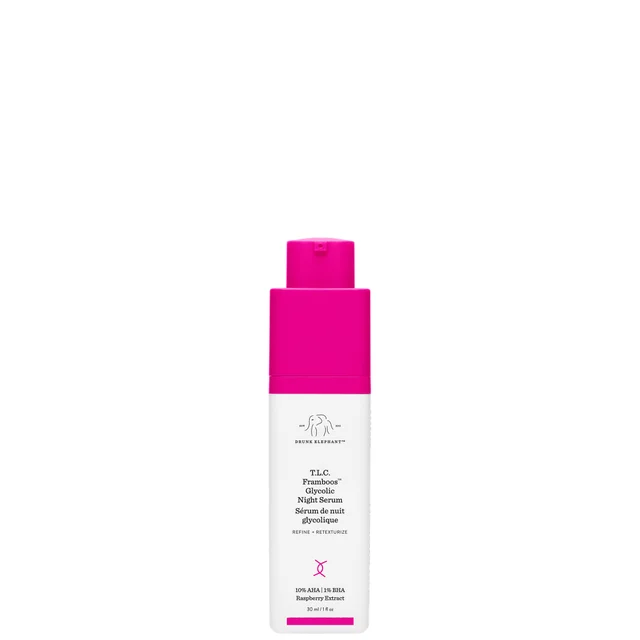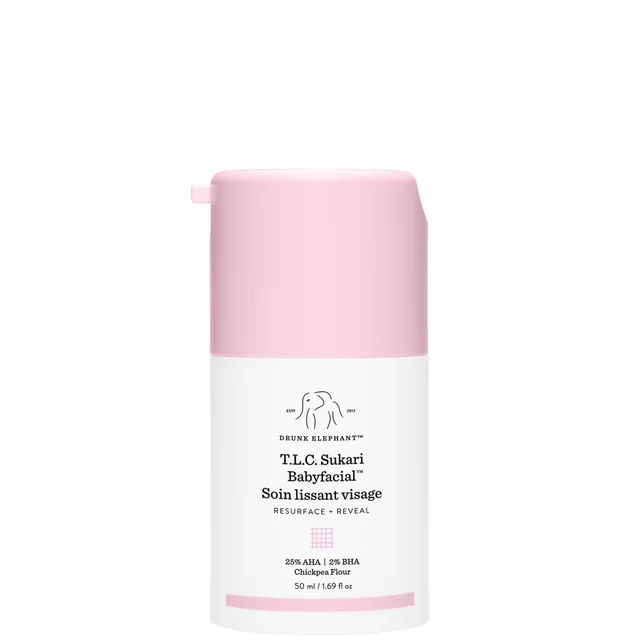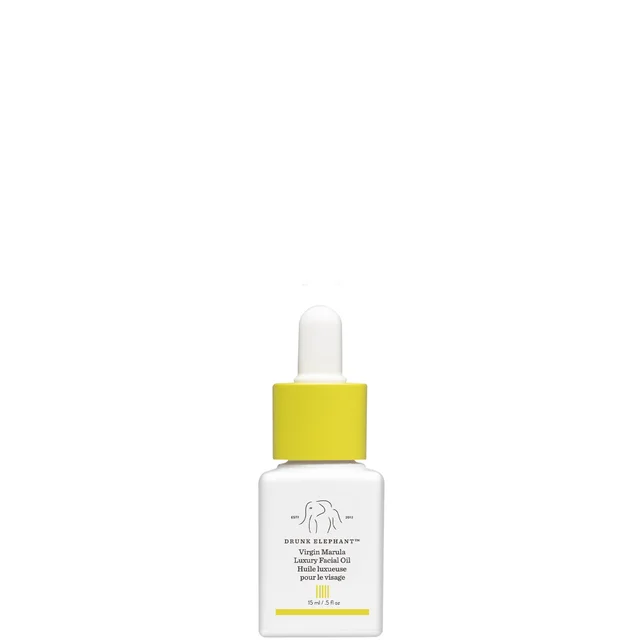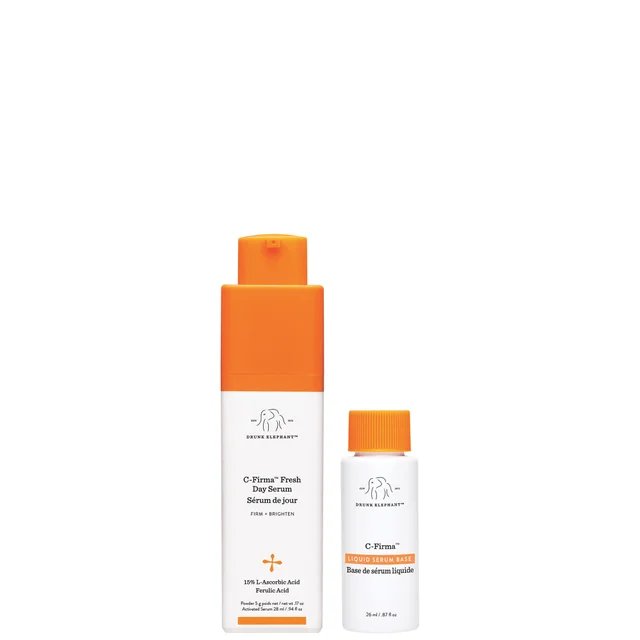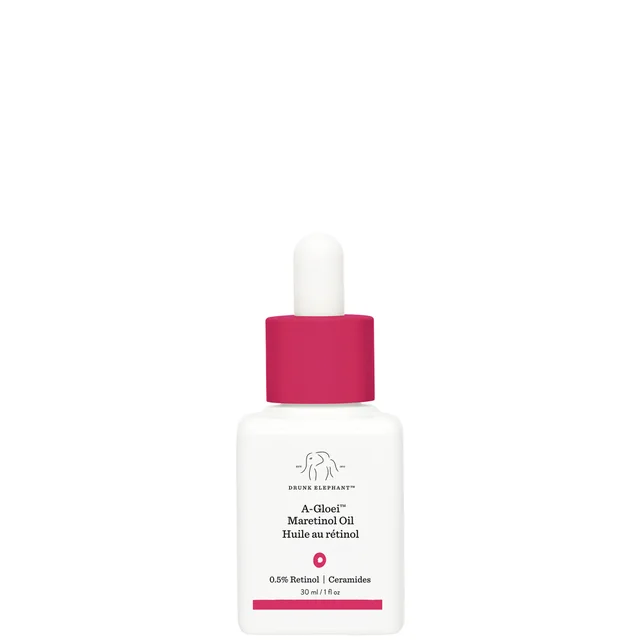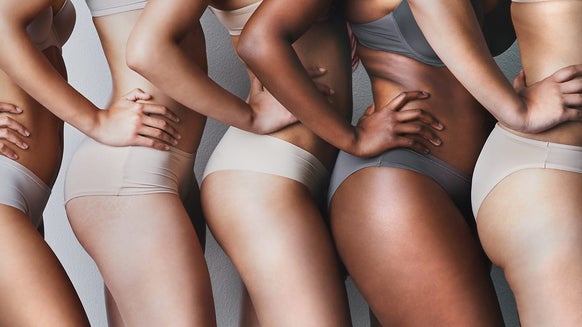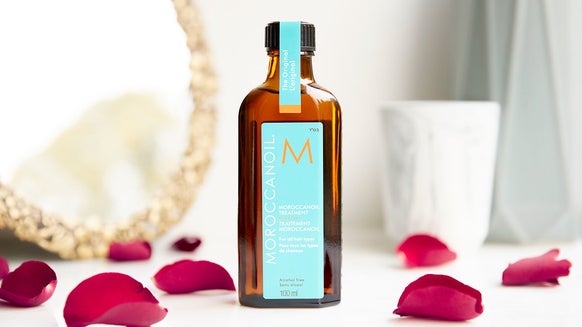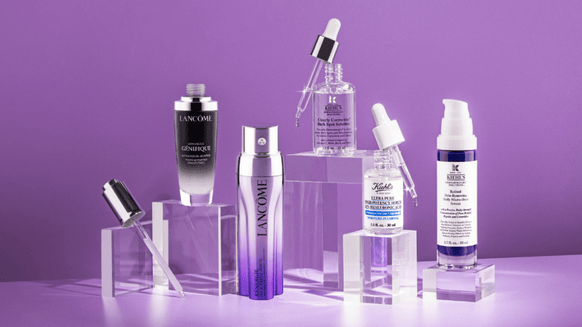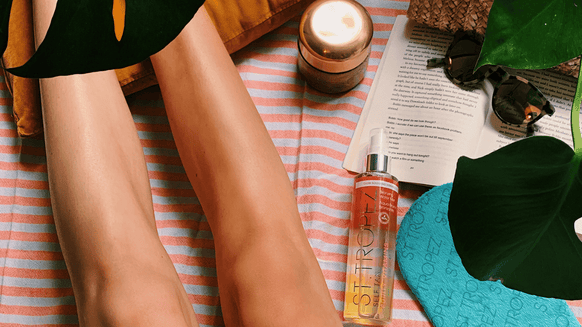Get to know your acids with our ultimate guide to exfoliation
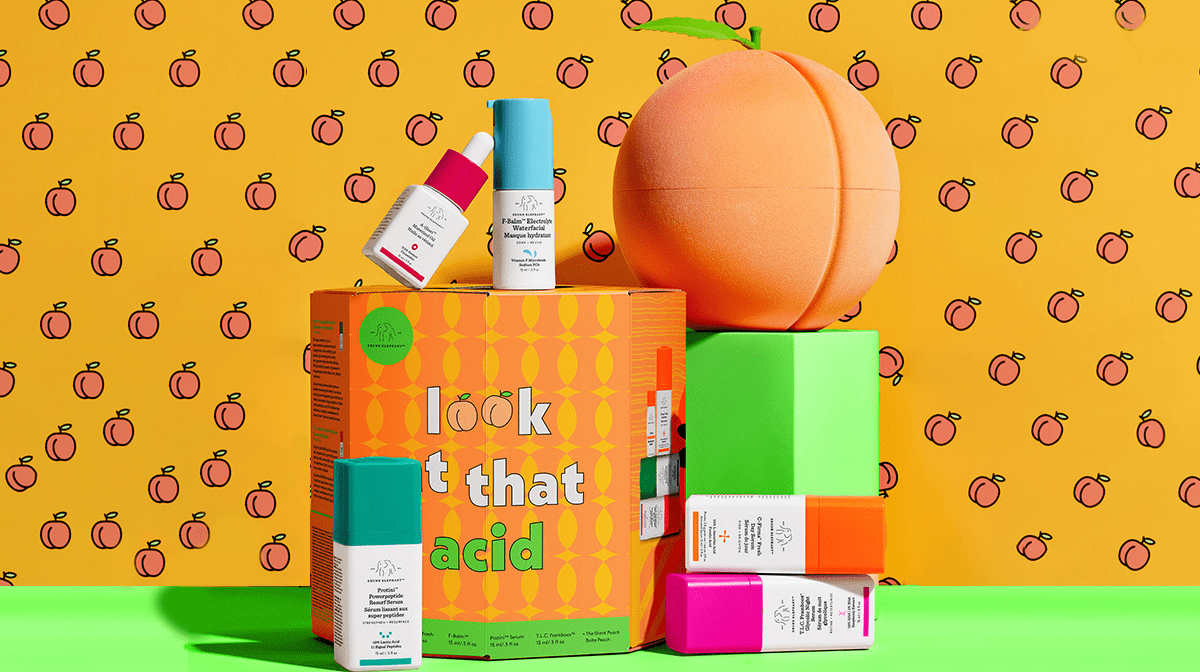
When it comes to exfoliation, many of us know that we should be doing it regularly, or even are incorporating it into our routines already, but still aren't exactly sure why. In celebration of the launch of the new Drunk Elephant Look At That Acid Kit (now sold out), a skincare kit containing every acid you need for smoother, brighter-looking skin, we teamed up with Drunk Elephant field trainer Kamil Nowak to clear up how to get clearer skin using acids.
What is exfoliation?
"Exfoliation helps to remove the dead cells from the surface of the skin, revealing a new layer of glowing, radiant skin underneath" explains Kamil.
What are the different types of exfoliators?
"There are 2 types of exfoliation: mechanical and chemical" says Kamil.
What is a physical exfoliation?
"Mechanical (or physical) exfoliating products contain microbeads, and granules to mechanically remove dead skin cells for an immediate result.
What is a chemical exfoliation?
"Chemical exfoliation products utilizes alpha hydroxy acids (AHAs) and beta hydroxy acids (BHA) to remove dead skin cells and promote the renewal of skin cells, for more anti-aging benefits" explains Kamil. He adds that they may be present in all types of skincare products from lotions to masks.
"At Drunk Elephant, we strongly focus on chemical exfoliation. I always recommend exfoliation, pretty much for everyone. It's more gentle or more potent, depending on their skin concern, but every skin needs it. Those dead skin cells will not go away by themselves".
When it comes to choosing the right or most effective exfoliant, Kamil explains that this varies according to the concentration and PH of the formula. "The higher the concentration and lower the pH (below 4), the more powerful their action is".
What are the benefits of AHAs?
One of the most common AHAs is glycolic acid says Kamil. "It’s a water-soluble acid derived from fruits and plants. It’s very frequently used in cosmetics and dermatology. It’s the smallest in molecular size and most powerful acid and potentially the most irritating when not formulated well".
- Promote skin renewal - break down junctions between cells and facilitate their renewal.
- Hydrate the skin - by increasing the water holding capacity.
- Reduce signs of aging - by promote dermis regeneration.
What are the benefits of BHAs?
"Salicylic acid is a Beta Hydroxy Acid. It’s oil-soluble and derived from plants. It’s effective even at a low concentration" states Kamil. "It acts in pores and dissolves fats and is frequently used in cosmetics particularly in the treatment from combination to oily skin" he adds.
- Promote skin renewal - by dissolving intercellular lipids and break down junctions between cells, facilitating their removal.
- Reduces imperfections - by unclogging pores by removing trapped dead cells and sebum excess and preventing bacterial growth.
- Sooths the skin - by reducing discomfort feelings.
How often should you exfoliate?
When it comes to how often you should exfoliate, this varies depending on the product you're using and the percentage of acid it contains according to Kamil. "For AHAs, it’s safe to exfoliate daily. I personally recommend using your daily acid treatment (usually 8% to 15% concentration), every other night" he adds. "For your more potent treatments (usually 20% to 30%), I would recommend using it once at week. Do not exceed that". If you’re new to acid treatments, Kamil stresses to start slow to avoid irritating or harming the skin.
Kamil advises using your exfoliant at night rather than in the morning to keep the skin protected. "By removing the superficial layers of the skin, acids can temporarily weaken the skin. At night, the skin is not exposed to external aggressions such as UV rays. It is also the moment when it regenerates the most which favours results. If you're new to chemical exfoliation, start off slowly and work up to a couple of times per week or even nightly, depending on how well your skin tolerates it".
Are there any skin types that should avoid exfoliation?
Although Kamil says that all skin types can exfoliate, he explains that you should tailor your exfoliation to you. "It all depends on a concentration. Our T.L.C. Framboos Glycolic Night Serum is safe to use daily and is suitable for all skin due to its lower concentration (10% AHAs blend and 1% BHA).
For your more potent formulations like our T.L.C. Sukari Babyfacial (a whopping 25% AHAs blend and 2% BHA), I would be conscious if you've never used such a product before. Start slow and always follow up with oil based moisture afterwards, like the Virgin Marula Oil.
How to avoid stripping the skin barrier when exfoliating
A key rule at Drunk Elephant, "avoid using any products that contain one or more of Suspicious 6 (silicones, fragrances and dyes, drying alcohols, SLS, chemical sunscreens and essential oils), as they can lead to over-sensitised skin" advises Kamil. Instead, he stresses to make sure you're using the right complement of ingredients and to start slowly: "Make sure that you are using the right complement of ingredients. For example, if you want to use, an AHA product and a retinol one, separate out the two products in time, using one in the morning and the other in the evening. You can also consider adding the second ingredient only after you have acclimated to the first one" he explains.
Just as important as it is not to over-cleanse, Kamil also explains that over-exfoliating can disrupt the skin's barrier. To avoid this, "listen to your skin! Watch how it reacts and adjust your routine accordingly" he says.
How to prepare the skin for exfoliation
"Start with removing any make up, sunscreen and other impurities" advises Kamil. "Make sure you are using pH balancing products, in this case especially a cleanser that is closer to the skin’s healthy pH (around 5.5). Whether you are using an AHA serum or treatment, be careful with your toner, as a lot of them already contain AHAs and BHAs, layering them together may lead to over-exfoliation and skin sensitivity".
What was in the Drunk Elephant Look At That Acid Kit?
"This potent antioxidant complex (15% l-ascorbic acid + 0.5% ferulic acid + 1% vitamin E) firms and brightens the look and feel of skin while minimizing the signs of photoaging, as well as damage caused by pollution and other environmental stressors. Your 0.5% ferulic acid here does not act an an exfoliator, instead it increasing the serums fast absorption" says Kamil. The daily serum is also blended with pumpkin ferment and pomegranate extract, "fruit enzymes that provide very gentle enzymatic exfoliation, which boosts the penetration of C-Firma’s antioxidant complex" explains Kamil.
"The C-Firma™Fresh is perfect for all skin, especially someone who is looking for a daytime serum that brightens uneven skin and protects the skin from environmental aggressors" he adds.
Containing 10% lactic acid, the Protini™ Serum is derived from the fermentation of sugar and lactic acid, and exfoliates the skin by dissolving the bonds that hold dead cells together, explains Kamil. "It’s considered a milder, more hydrating AHA and is safe to use daytime and night time. It’s a perfect beginner product if you are new to acids and you want a strong, anti-aging results. It is also packed with 11 signal peptides, which are made up of amino acids and plant-derived growth factors, signal peptides help to boost skin’s self-renewal, binding moisture to skin and plumping, firming, and restoring bounce".
"The A-Gloei™ is a glow-giving, skin-smoothing booster that provides a gentle but effective dose of 0.5% vegan retinol with barrier-supportive, plant-derived ceramides and pure, antioxidant-rich virgin marula oil for a healthier-looking, more youthful complexion" says Kamil. "Designed for both new and experienced retinol users, A-Gloei™ was created with all skin types in mind. Retinol gets a bad rap for being sensitizing, but A-Gloei™ is formulated with soothing marula oil to gently deliver retinol to skin, ensuring high efficacy without redness or irritation, which makes it perfect for anyone who is hesitant to use a retinol. This is the perfect way to ease your way in—no ramp-up needed!"
"Morning or night, apply 2-3 drops to a clean, dry face. May be mixed with any Drunk Elephant moisturiser or serum. Always use a broad-spectrum sunscreen if using during the day" advises Kamil.
Kamil's top tip: "mix A-Gloei™ with C-Firma™ for even greater brightening and firming benefits".
"T.L.C. Framboos™ is a 10% AHA blend of glycolic acid, plus tartaric, lactic, and citric acids which exfoliate surface dead skin cells to smooth and brighten the appearance of skin" says Kamil. The 1% salicylic acid, a BHA, loosens sebum to unclog pores and raspberry extract in the formula rehydrates and soothes damaged skin while fighting free radical damage with antioxidants.
"In the evening, apply to a clean, dry face (and even to the chest and backs of hands), avoiding the eye area" instructs Kamil. "Mix with Virgin Marula Oil for a dose of moisture and barrier-boosting fatty acids". "Slight tingling may be experienced, particularly for the first few days of application. This typically dissipates as your skin becomes adjusted" warns Kamil, who advises starting slowly by using the product every other night.
Although the F-Balm itself does not have exfoliating properties, explains Kamil, it is rich in acids, such as fatty omega acids such as vitamin F. "Vitamin F (linolenic and linoleic acids) are soothing fatty acids that play a key role in maintaining hydration levels, improving skin texture and suppleness while reducing inflammation and improving acid mantle strength" explains Kamil.
A 25% 4-electrolyte blend (coconut water, sodium PCA, magnesium PCA, and prickly pear extract) in the formula offers antioxidant and humectant properties which Kamil explains are "vital to helping maintain hydration levels in skin, improving barrier strength and lipid content, calming redness, and protecting against environmental dehydration".
"Niacinamide (vitamin B3) in the F-Blam "improves signs of aging (fine lines, wrinkles, loss of firmness) as well as uneven tone and texture" adds Kamil.
How to care for the skin after exfoliation
"Always follow up using a nourishing moisturizer or an oil" advises Kamil. "By removing the superficial layers of the skin, acids can temporarily weaken the skin. Bringing nourishing and moisturising ingredients to the skin is key to rebuilding the protective barrier (intercellular lipid cement and hydrolipidic film) and restoring comfort" he adds. Kamil's top tip, "I personally love using our Virgin Marula Oil after intense treatment like T.L.C Sukari Babyfacial as aftercare".

Working with brands at LOOKFANTASTIC for over two years I have developed my knowledge of all things beauty from key skincare concerns to niche makeup tricks and haircare hacks. I have a major passion for finding effective solutions that are easily accessible to everyone so that we can all achieve our best, glowing complexion.
